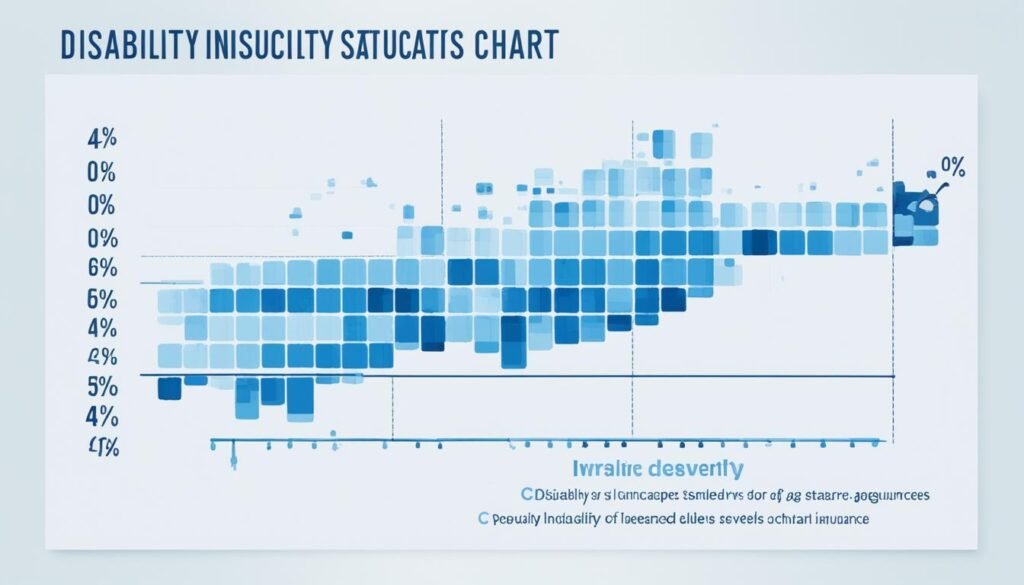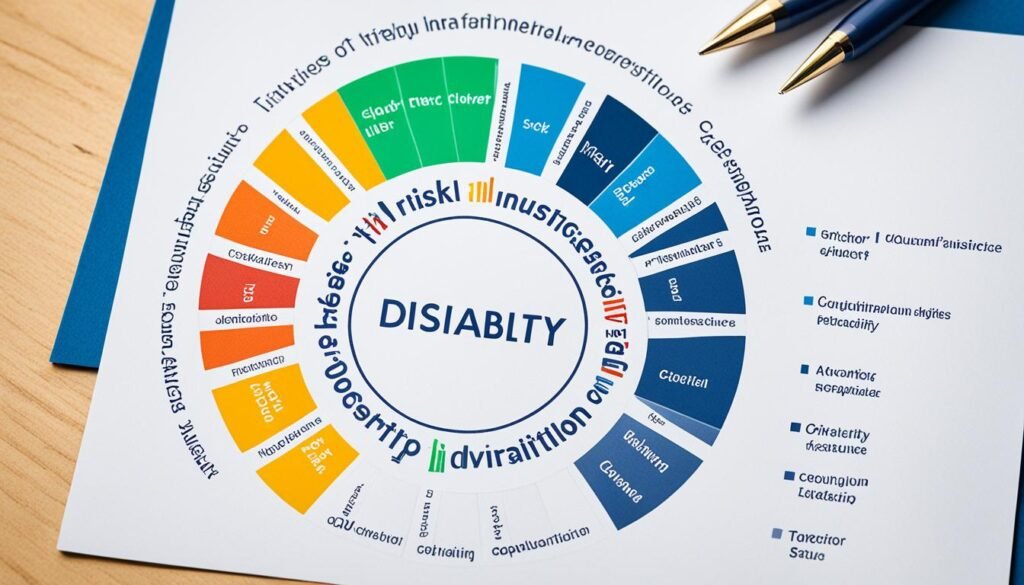We live in uncertain times, making it key to protect our income. Disability insurance is a safety net, crucial for financial security during tough times. It helps keep our lifestyle and meet financial needs, even if we can’t work due to health issues.
The U.S. Social Security Administration says 25% of 20-year-olds may face a disability before retirement age. Without this news, it’s clear income protection is vital. Disability insurance steps in, covering 60-80% of your after-tax earnings. This provides a steady financial path when faced with hard times.
Many of us don’t think we’ll become disabled. Yet, things like cancer, heart disease, and musculoskeletal disorders are frequent causes of long-term disability. Having disability insurance means more than just income protection. It means peace of mind for us and our families. It’s a must in any solid financial plan, helping us survive any challenge.
Understanding Disability Insurance
Life can bring unexpected hurdles. This is why disability insurance is vital for our financial health. It safeguards our income if an illness or injury keeps us from working.
Definition and Purpose
Disability insurance steps in when we’re out of work. It covers part of our salary, helping with bills and daily costs. This policy is like a financial help line, sparing us from draining savings or seeking help from family.
Types of Disability Insurance
There are two key forms of disability insurance:
- Short-term disability coverage: Often covers 3-6 months
- Long-term disability coverage: Can support you for many years or up to retirement
How Disability Insurance Works
If we can’t work, we tell our insurer and begin a claim. After an initial waiting period, often 90 days, benefits start coming in. These benefits are usually between 45% and 65% of our total income. The final figure depends on our policy and condition.
| Feature | Short-Term Disability | Long-Term Disability |
|---|---|---|
| Waiting Period | 0-14 days | Weeks to months |
| Benefit Duration | 3-6 months | Years to retirement |
| Benefit Amount | 60-70% of income | 45-65% of income |
Did you know, 25% of young workers will face a life-changing event in their working years? The average claim lasts for almost three years. This makes disability insurance a key part of smart financial planning.
The Importance of Income Protection
Making sure we can earn money is key to our finances. Sometimes, we don’t see how life’s surprises can stop us from working. A lot of people claim disability benefits. This can really hurt our money situation.
Can you believe that 46% of people lose their homes due to disability? That’s a big number. It shows why we need to protect our income. Without it, we could lose our jobs and homes.
“There is a 50% chance that a 30-year-old will be disabled for more than three months before age 65.”
Think about this fact. It’s why we need to consider the chance of becoming disabled. Having insurance for our income can help a lot. It keeps our life going even if we can’t work. This kind of insurance means we can keep up with bills and not worry about our future money.
- Monthly benefits of up to $10,000
- Replacement of 60-67% of annual gross earnings
- Tax-free benefits if premiums are paid with after-tax dollars
- Benefit waiting periods of 28, 90, or 180 days
- Annual benefit increases up to 3% with the Benefit Booster feature
By getting income protection, we protect our money and peace of mind. It’s a way to keep our lifestyle secure. This is important for our financial future, especially when things go wrong.
Disability Statistics: Why You Should Care
Disability numbers show how financially at risk many of us are. We don’t often think about becoming disabled during our working years. Yet, the facts show a different truth.
Probability of Becoming Disabled
The chance of becoming disabled is higher than you might think. In the U.S., up to 1 in 4 adults have a disability. What’s more, 1 in 4 twenty-year-olds today might face a whole year without work due to disability by the time they retire.

Duration and Types of Disability Claims
Every year, around 5% of workers in the U.S. face a short-term disability. This might last six months or less. The most common causes are pregnancies, musculoskeletal disorders, injuries, digestive issues, and mental health problems.
- Pregnancies (22.3%)
- Musculoskeletal disorders (18.5%)
- Injuries (11.4%)
- Digestive disorders (7.4%)
- Mental health issues (7.3%)
Financial Impact on Individuals and Families
Disability’s financial hit can be crushing. An astounding 51 million working Americans have no more disability insurance than Social Security. This gap in coverage leaves many families open to financial trouble.
| Financial Readiness | Percentage of Households |
|---|---|
| Can cover 3 months of expenses | 40% |
| Can cover 6 months of expenses | 28% |
| Lack disability insurance | 54.3% |
These figures emphasize how crucial financial planning and disability insurance are. Without the right protection, a disability could severely harm your finances. This affects not only you but your whole family.
Disability Insurance vs. Other Financial Safety Nets
There are many ways to keep our money safe, but disability insurance is key. It’s different from workers’ compensation. That only helps you if you’re hurt at work. Disability insurance, on the other hand, helps when you can’t work due to many reasons.
Getting Social Security disability help can be hard and slow. But, disability insurance pays faster and covers more. It’s there for you whenever you might need it.
- Employer-provided coverage typically replaces only 60% or less of your income
- Personal savings can quickly deplete during extended periods of disability
- Workers’ compensation is limited to work-related injuries
- Social Security disability has strict eligibility requirements and long waiting periods
Disability insurance offers many benefits that can change with your needs. Plus, you can take it with you even if you switch jobs. This keeps you safe in a world full of surprises.
“One in four 20-year-olds can expect to be out of work for at least a year due to a health problem before reaching typical retirement age.”
Because of these facts, disability insurance is a wise financial move. It’s a backup plan if you can’t work. So, your money won’t be at risk because of unexpected health issues.
Key Features of Disability Insurance Policies
It’s vital to know the main parts of a disability policy. We’ll look at what you need in a good insurance plan.
Benefit Amount and Duration
Disability insurance pays between 60% to 80% of your wage. You could get this help for a few years or until you retire. Make sure the amount you pick covers your bills well.
Elimination Period
During the elimination period, you wait for benefits to start. Choosing a longer wait time can lower what you pay for the policy. Think about how much you have saved and if you can wait a bit before income starts again.
Definition of Disability
The meaning of ‘disability’ changes in each policy:
- If you can’t do your exact job, the policy may see you as disabled.
- If you’re not able to perform any job that fits your skills and education, you might be considered disabled too.
Riders and Additional Coverage Options
Extra options can make your coverage better. You might add things like:
| Rider | Description |
|---|---|
| Cost of Living Adjustment | Raises benefits with the cost of living |
| Future Increase Option | Lets you buy more insurance without a health check |
| Residual Disability | Pays when you can just work part-time |
Finding the best disability policy means getting good cover without high costs. Always check and understand these options when you buy a plan.
Who Needs Disability Insurance?
Disability insurance is vital for our financial safety. Many of us don’t think we’ll become disabled. Yet, over 1 in 4 20-year-olds will face a disability. This happens before they retire.
Who needs it most? Anyone who needs their income to pay daily bills. For example, primary earners, those with high living costs, self-employed people, parents, and those in risky jobs.
Even with job benefits, one may need extra coverage. 68% of people can’t pay bills for a month without work. So, having enough disability insurance is wise.
Disability insurance covers more than just accidents. It’s crucial because most disabilities come from illnesses that affect anyone.
Disability insurance costs between 1-3% of your salary. At $75,000 a year, this is $14-$43 each week. It’s a small amount for big security.
| Income Level | Weekly Cost Range | Monthly Cost Range |
|---|---|---|
| $50,000 | $9 – $29 | $39 – $125 |
| $75,000 | $14 – $43 | $61 – $188 |
| $100,000 | $19 – $58 | $82 – $250 |
Usually, it covers 60% of your earnings. Think about extra coverage too. This extra policy can fill any financial holes.
Disability Insurance for Self-Employed Individuals
Self-employed people have special needs when it comes to protecting their income. Disability insurance is crucial for those working on their own. Let’s see how entrepreneurs can ensure their financial future stays secure.
Unique Challenges for Entrepreneurs
Your earnings, as a self-employed individual, come from your work. If you are unable to work due to a disability, you could lose what you’ve worked for. Unlike those with benefits from a job, you must create your own safety net.
Tailoring Coverage for Business Owners
Look for disability insurance that protects your personal and business incomes. Policies should include:
- Own-occupation coverage
- Flexible benefit periods
- Riders for business support and loan protection
In certain states, you need to earn at least $4,600 in yearly net profit to be eligible for Disability Insurance Elective Coverage (DIEC).
Business Overhead Expense Insurance
This coverage helps your business stay afloat if you can’t work. It pays for expenses like rent, salaries, and utilities. Matching personal disability insurance with business coverage gives a strong safety net for you and your business.
| Insurance Type | Covers | Benefit |
|---|---|---|
| Personal Disability | Your Income | Up to 65% Income Replacement |
| Business Overhead Expense | Business Costs | Ongoing Operational Expenses |
Ensure your hard work stays protected. As a self-employed person, getting a full disability insurance plan is vital, not just wise.
Employer-Provided vs. Individual Disability Insurance
Disability insurance is crucial, but we often ignore it. Let’s look at the differences between what your job might offer and what you can buy for yourself. This will help you choose wisely.
Employer-provided plans are good, yet they might not cover everything. They typically pay 50% to 60% of your salary, with a cap. Short-term plans could cover all your earnings after a waiting period.
Buying your own insurance gives you more options and power. You can get higher benefits and keep your plan if you switch jobs. Plus, these policies might let you adjust for the cost of living.
- One in four 20-year-olds will experience a disability before retirement
- The average long-term disability claim lasts almost 3 years
- Only 40% of American adults have enough savings to cover 3 months of living expenses
While company insurance may be cheaper, your personal plan can be more thorough. It stays with you and no one can take it away. However, your employer could end the group policy.
Group Just Enough
Adding personal insurance to your job’s coverage can really beef up your protection. You could get up to 70% of your paycheck. Always remember, securing your finances is always a smart move.
The Cost of Disability Insurance
Figuring out disability insurance prices is key for protecting your money. You should know what makes costs go up or down and how to save.
Factors Affecting Premiums
Disability insurance usually costs 1% to 4% of your year’s income. What you pay depends on certain things:
- Age and health: If you’re young and healthy, insurance might be cheaper
- Occupation: Jobs that are more dangerous can cost more to insure
- Benefit amount and period: More pay and longer time pay mean higher costs
- Elimination period: Waiting a while before getting paid can lower your bill

Making Coverage More Affordable
We know money can be tight, making disability insurance feel pricey. But there are ways to cut costs:
- Consider a longer wait before you start getting benefits
- Shorten the time you get benefits for
- Choose less money for your benefits
- Look into group plans through work organizations
It’s crucial to balance saving with having enough protection. Insurers look at your personal details to set a price. So talking with an expert is smart when picking options.
| Annual Salary | Yearly Cost Range | Monthly Payment Range |
|---|---|---|
| $50,000 | $500 – $1,500 | $60 – $125 |
| $100,000 | $1,000 – $3,000 | $83 – $250 |
| $150,000 | $1,500 – $4,500 | $125 – $375 |
Think hard about what you need and your options. This way, you can get disability insurance that’s both affordable and protective.
Disability Insurance and Long-Term Financial Planning
Long-term disability insurance is a vital part of our financial planning. It’s key for protecting our future. With claims typically lasting over 2.5 years, we can’t ignore its role. This coverage safeguards our income and keeps our savings safe if we’re unable to work. It ensures our retirement stays on course.
This insurance is crucial for our financial safety. It’s part of a bigger puzzle that includes life insurance and retirement funds. If we have a policy that pays us up to 80% of our usual earnings, it keeps us from using up our savings. This is very important, as a quarter of Americans deal with a disability.
More than a quarter of adults in the U.S. find it hard to pay bills or face a $400 emergency. Disability insurance shields us from this financial worry. It lets us keep making money and live normally, even if we’re unable to work for a long time. Adding this coverage to our financial strategy makes our future plans stronger.



